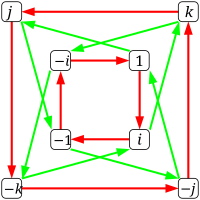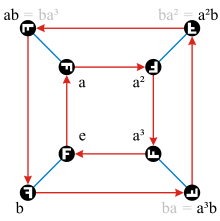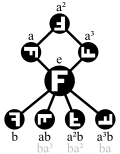Quaternion group
| 1 | i | j | k | |
|---|---|---|---|---|
| 1 | 1 | i | j | k |
| i | i | −1 | k | −j |
| j | j | −k | −1 | i |
| k | k | j | −i | −1 |
| Algebraic structure → Group theory Group theory |
|---|
 |

In group theory, the quaternion group Q8 (sometimes just denoted by Q) is a non-abelian group of order eight, isomorphic to the eight-element subset of the quaternions under multiplication. It is given by the group presentation
where e is the identity element and e commutes with the other elements of the group.
Another presentation of Q8 is
Compared to dihedral group[]
The quaternion group Q8 has the same order as the dihedral group D4, but a different structure, as shown by their Cayley and cycle graphs:
| Q8 | D4 | |
|---|---|---|
| Cayley graph |  Red arrows connect g→gi, green connect g→gj. |

|
| Cycle graph | 
|

|
In the diagrams for D4, the group elements are marked with their action on a letter F in the defining representation R2. The same cannot be done for Q8, since it has no faithful representation in R2 or R3. D4 can be realized as a subset of the split-quaternions in the same way that Q8 can be viewed as a subset of the quaternions.
Cayley table[]
The Cayley table (multiplication table) for Q8 is given by:[1]
| × | e | e | i | i | j | j | k | k |
|---|---|---|---|---|---|---|---|---|
| e | e | e | i | i | j | j | k | k |
| e | e | e | i | i | j | j | k | k |
| i | i | i | e | e | k | k | j | j |
| i | i | i | e | e | k | k | j | j |
| j | j | j | k | k | e | e | i | i |
| j | j | j | k | k | e | e | i | i |
| k | k | k | j | j | i | i | e | e |
| k | k | k | j | j | i | i | e | e |
Properties[]
The elements i, j, and k all have order four in Q8 and any two of them generate the entire group. Another presentation of Q8[2] based in only two elements to skip this redundancy is:
One may take, for instance, , and .
The quaternion group has the unusual property of being Hamiltonian: Q8 is non-abelian, but every subgroup is normal.[3] Every Hamiltonian group contains a copy of Q8.[4]
The quaternion group Q8 and the dihedral group D4 are the two smallest examples of a nilpotent non-abelian group.
The center and the commutator subgroup of Q8 is the subgroup . The inner automorphism group of Q8 is given by the group modulo its center, i.e. the factor group Q8/{e,e}, which is isomorphic to the Klein four-group V. The full automorphism group of Q8 is isomorphic to S4, the symmetric group on four letters (see Matrix representations below), and the outer automorphism group of Q8 is thus S4/V, which is isomorphic to S3.
The quaternion group Q8 has five conjugacy classes, { e }, { e }, { i, i }, { j, j }, { k, k }, and so five irreducible representations over the complex numbers, with dimensions 1,1,1,1,2:
Trivial representation
Sign representations with i,j,k-kernel: Q8 has three maximal normal subgroups: the cyclic subgroups generated by i, j, and k respectively. For each maximal normal subgroup N, we obtain a one-dimensional representation factoring through the 2-element quotient group G/N. The representation sends elements of N to 1, and elements outside N to -1.
2-dimensional representation: Described below in Matrix representations.
The character table of Q8 turns out to be the same as that of D4:
| Representation(ρ)/Conjugacy class | { e } | { e } | { i, i } | { j, j } | { k, k } |
|---|---|---|---|---|---|
| Trivial representation | 1 | 1 | 1 | 1 | 1 |
| Sign representation with i-kernel | 1 | 1 | 1 | -1 | -1 |
| Sign representation with j-kernel | 1 | 1 | -1 | 1 | -1 |
| Sign representation with k-kernel | 1 | 1 | -1 | -1 | 1 |
| 2-dimensional representation | 2 | -2 | 0 | 0 | 0 |
Since the irreducible characters in the rows above have real values, this gives the decomposition of the real group algebra of into minimal two-sided ideals: , where the idempotents correspond to the irreducibles: , so that
.
Each of these irreducible ideals is isomorphic to a real central simple algebra, the first four to the real field . The last ideal is isomorphic to the skew field of quaternions by the correspondence:
Furthermore, the projection homomorphism given by has kernel ideal generated by the idempotent:
so the quaternions can also be obtained as the quotient ring .
The complex group algebra is thus , where is the algebra of biquaternions.
Matrix representations[]
The two-dimensional irreducible complex representation described above gives the quaternion group Q8 as a subgroup of the general linear group . The quaternion group is a multiplicative subgroup of the quaternion algebra , which has a regular representation by left multiplication on itself considered as a complex vector space with basis , so that corresponds to the C-linear mapping . The resulting representation is given by:
Since all of the above matrices have unit determinant, this is a representation of Q8 in the special linear group SL(2,C).[5]
A variant gives a representation by unitary matrices (table at right). Let correspond to the linear mapping , so that is given by:
It is worth noting that physicists exclusively use a different convention for the matrix representation to make contact with the usual Pauli matrices:
This particular choice is convenient and elegant when one describes spin-1/2 states in the basis and considers angular momentum ladder operators .

There is also an important action of Q8 on the 2-dimensional vector space over the finite field F3 = {0,1,−1} (table at right). A modular representation is given by
This representation can be obtained from the extension field F9 = F3[k] = F31 + F3k, where k2 = −1 and the multiplicative group (F9)× has generators ±(k+1), ±(k-1) of order 8. The two-dimensional F3-vector space F9 admits the linear mappings for z in F9, as well as the Frobenius automorphism satisfying and . Then the above representation matrices are , , , and .
The above representation realizes Q8 as a normal subgroup of GL(2, 3). Thus, for each matrix , we have a group automorphism defined by , with . In fact, these give the full automorphism group as:
,
This is isomorphic to the symmetric group S4 since the linear mappings permute the four one-dimensional subspaces of , i.e. the four points of the projective space .
Also, this representation permutes the eight non-zero vectors of (F3)2, giving an embedding of Q8 in the symmetric group S8, in addition to the embeddings given by the regular representations.
Galois group[]
As Richard Dean showed in 1981, the quaternion group can be presented as the Galois group Gal(T/Q) where Q is the field of rational numbers and T is the splitting field over Q of the polynomial
- .
The development uses the fundamental theorem of Galois theory in specifying four intermediate fields between Q and T and their Galois groups, as well as two theorems on cyclic extension of degree four over a field.[6]
Generalized quaternion group[]
A generalized quaternion group Q4n of order 4n is defined by the presentation[2]
for an integer n ≥ 2, with the usual quaternion group given by n = 2.[7] Coxeter calls Q4n the dicyclic group , a special case of the binary polyhedral group and related to the polyhedral group and the dihedral group . The generalized quaternion group can be realized as the subgroup of generated by
where .[2] It can also be realized as the subgroup of unit quaternions generated by[8] and .
The generalized quaternion groups have the property that every abelian subgroup is cyclic.[9] It can be shown that a finite p-group with this property (every abelian subgroup is cyclic) is either cyclic or a generalized quaternion group as defined above.[10] Another characterization is that a finite p-group in which there is a unique subgroup of order p is either cyclic or a 2-group isomorphic to generalized quaternion group.[11] In particular, for a finite field F with odd characteristic, the 2-Sylow subgroup of SL2(F) is non-abelian and has only one subgroup of order 2, so this 2-Sylow subgroup must be a generalized quaternion group, (Gorenstein 1980, p. 42). Letting pr be the size of F, where p is prime, the size of the 2-Sylow subgroup of SL2(F) is 2n, where n = ord2(p2 − 1) + ord2(r).
The Brauer–Suzuki theorem shows that the groups whose Sylow 2-subgroups are generalized quaternion cannot be simple.
Another terminology reserves the name "generalized quaternion group" for a dicyclic group of order a power of 2,[12] which admits the presentation
See also
- 16-cell
- Binary tetrahedral group
- Clifford algebra
- Dicyclic group
- Hurwitz integral quaternion
- List of small groups
Notes[]
- ^ See also a table from Wolfram Alpha
- ^ a b c Johnson 1980, pp. 44–45
- ^ See Hall (1999), p. 190
- ^ See Kurosh (1979), p. 67
- ^ Artin 1991
- ^ Dean, Richard (1981). "A Rational Polynomial whose Group is the Quaternions". The American Mathematical Monthly. 88 (1): 42–45. JSTOR 2320711.
- ^ Some authors (e.g., Rotman 1995, pp. 87, 351) refer to this group as the dicyclic group, reserving the name generalized quaternion group to the case where n is a power of 2.
- ^ Brown 1982, p. 98
- ^ Brown 1982, p. 101, exercise 1
- ^ Cartan & Eilenberg 1999, Theorem 11.6, p. 262
- ^ Brown 1982, Theorem 4.3, p. 99
- ^ Roman, Steven (2011). Fundamentals of Group Theory: An Advanced Approach. Springer. pp. 347–348. ISBN 9780817683016.
References[]
- Artin, Michael (1991), Algebra, Prentice Hall, ISBN 978-0-13-004763-2
- Brown, Kenneth S. (1982), Cohomology of groups (3rd ed.), Springer-Verlag, ISBN 978-0-387-90688-1
- Cartan, Henri; Eilenberg, Samuel (1999), Homological Algebra, Princeton University Press, ISBN 978-0-691-04991-5
- Coxeter, H. S. M. & Moser, W. O. J. (1980). Generators and Relations for Discrete Groups. New York: Springer-Verlag. ISBN 0-387-09212-9.
- Dean, Richard A. (1981) "A rational polynomial whose group is the quaternions", American Mathematical Monthly 88:42–5.
- Gorenstein, D. (1980), Finite Groups, New York: Chelsea, ISBN 978-0-8284-0301-6, MR 0569209
- Johnson, David L. (1980), Topics in the theory of group presentations, Cambridge University Press, ISBN 978-0-521-23108-4, MR 0695161
- Rotman, Joseph J. (1995), An introduction to the theory of groups (4th ed.), Springer-Verlag, ISBN 978-0-387-94285-8
- P.R. Girard (1984) "The quaternion group and modern physics", European Journal of Physics 5:25–32.
- Hall, Marshall (1999), The theory of groups (2nd ed.), AMS Bookstore, ISBN 0-8218-1967-4
- Kurosh, Alexander G. (1979), Theory of Groups, AMS Bookstore, ISBN 0-8284-0107-1
External links[]
- Weisstein, Eric W. "Quaternion group". MathWorld.
- Quaternion groups on GroupNames
- Quaternion group on GroupProps
- Conrad, Keith. "Generalized Quaternions"
- Group theory
- Finite groups
- Quaternions










![{\displaystyle \textstyle \mathbb {R} [Q_{8}]\ =\ \bigoplus _{\rho }(e_{\rho })}](https://wikimedia.org/api/rest_v1/media/math/render/svg/1761120670b220c341d6011a5828e02fbea91465)
![{\displaystyle e_{\rho }\in \mathbb {R} [Q_{8}]}](https://wikimedia.org/api/rest_v1/media/math/render/svg/998bce07bcab28516257658681275cfa3fa3565d)










![{\displaystyle \mathbb {R} [Q_{8}]\to (e_{2})\cong \mathbb {H} }](https://wikimedia.org/api/rest_v1/media/math/render/svg/ed575d6fe2a2f4ad1b041497334d7e11f32fe5a3)


![{\displaystyle \mathbb {R} [Q_{8}]/(e+{\bar {e}})\cong \mathbb {H} }](https://wikimedia.org/api/rest_v1/media/math/render/svg/53ab95cc1e1943df7e6665e199487fb543252663)
![{\displaystyle \mathbb {C} [Q_{8}]\cong \mathbb {C} ^{\oplus 4}\oplus M_{2}(\mathbb {C} )}](https://wikimedia.org/api/rest_v1/media/math/render/svg/86853166cd0baf213603720e72f18b1175ae519d)















































